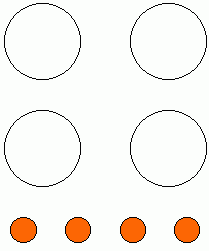Usability is not an add-on
Steven Pemberton
CWI, Amsterdam
A thought experiment
What are the features of websites that you go back to regularly, that
differentiate them from websites with the same purpose?
Differentiating features
Forrester did some research on this
- Good content (75%)
- Usability (66%)
- Speed (58%)
- Frequency of updating (54%)
(the rest is noise: 14% and lower)
Surprises
- User testing is the first item to go when looking for reduced costs
- Many web-building companies have no usability experts on their
staff
- Many web-building companies build sites that are measurably
unusable
Software
- Usability is just as important for software
- Although the usability advantage has less effect than with websites, it
still plays a role via word-of-mouth (E.g. Quicken)
- It definitely improves the quality of software for the user
Why do we use programs?
- To get a task done
- A program is seldom an end in itself
- Any interruption in the task, because you have to think about the
interface, is a failure of the interface
The task
- Task
is the word used in user interface circles to refer to whatever it is
you are trying to achieve
- There is always a task (even when vegging out in front of the TV)
- Tasks are usually (unconsciously) split by the user into sub-tasks (and
so on)
The user
- The user is always right!
- If the user fails to achieve something because of the interface, it is
the interface's fault: it doesn't address that sort of
user
- Most programs choose to address some range of users
What is usability?
Usability can be summarised as three factors:
- Efficiency: how quickly you achieve what you want
- Effectiveness: how correctly you achieve it
- Satisfaction: how much you enjoy doing it
Why Usability?
- People using your software will work faster
- They will produce better results
- They will be happier
- More people will buy your software
Compromises
Sometimes usability factors have to be balanced out:
- An experiment with 3 chess-playing interfaces (command-line, mouse,
and real manipulation of chess pieces) showed that the mouse was the
fastest
- But with real manipulation, the user won more often (was more
effective)
- Games deliberately reduce your efficiency
Surprises
The psychology of human beings can cause some surprising results:
- In a test with three methods of writing (pen on paper, a text
editor, a word processor) users wrote less with a pen but of a higher
quality, more with a text editor but of a lower quality, and more
with a word processor but with a higher quality.
Transparency
A fourth aim of user interfaces is transparency: you don't notice
a good user interface, you spend all your time solving the problem.
Not just buttons and menus!
- A typical lay-error is to think that user interfaces are just about
buttons and menus
- This is just surface (and largely uninteresting)
- More interesting is function (what you can do) and
attitude
Learnability vs Ease of use
- Another lay-error is to think that Usability is only about making
programs easy-to-use for beginners
- While this is an admirable aim, it may get in the way of efficiency,
effectiveness and/or satisfaction of expert users (who may be your major
class of users)
- This probably explains the success of emacs
Interfaces are everywhere
- It is wrong to think that user interfaces are the exclusive domain of
computer software
- It is worth adopting a critical attitude to the user interfaces of
everything
Interfaces are everywhere
- It is wrong to think that user interfaces are the exclusive domain of
computer software
- It is worth adopting a critical attitude to the user interfaces of
everything
- Warning: this can ruin the rest of your life...
Bad everyday interfaces
Doors are a good example of everyday interfaces that often are bad:
- Doors that suggest they need to be pulled, but actually need to be
pushed
- They often use a simple help system: PUSH
A good door interface doesn't need this
Bad everyday interfaces 2
Typical cookers have 4 burners, and 4 switches organised in a different
way, that therefore need a help system (little pictures) to help you use
them

Bad everyday interfaces 3
And so it goes on and on...
- Unprogrammable video players
- Hi-fi's where the on-light is not next to the on-off switch
- Light switches on the hinge side of the door
- ... (think of some more yourself)
Bad interfaces
- Bad interfaces come between the user and the task
- They create a new sub-task: how do I get round this problem
The ownership of interfaces
- Programmers often have a similar attitude to their programs to that of
parents towards their children: they can do no wrong
- It can be very hard to persuade programmers that there is something
wrong with their program's interface
Factors in usability
There are many dimensions to usability, for instance:
- Psychology
- Culture
- International issues
- (Dis)/ability levels
- etc.
Usability is not an add-on
Since function and attitude are determining factors of usability,
trying to make a program usable post facto may only produce a
local optimum

Build usability in from the start
- Employ usability experts
- Involve them from the start
- Plan to build iteratively
- User test regularly
- User tests need only be small: 7 users will smoke out most remaining
problems
- Make the programmers watch the usability tests
Usability: Where do I get it?
- Get your attitude from
- Don Norman The Design of Everyday Things
- Bruce Tognazzini Tog On Interface
- Books by Edward Tufte
- Get your information from
- The annual CHI conference
- ACM interactions
- Get your people from/send them to


